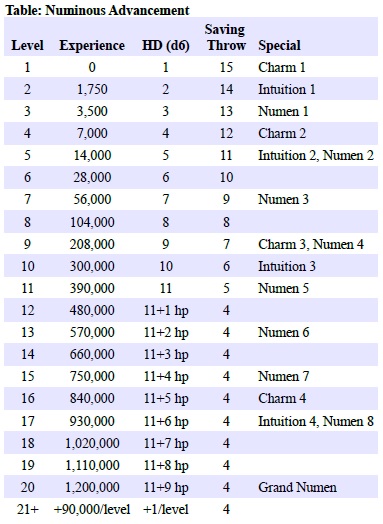
mystic: (adj.) having seemingly supernatural qualities or powers
Today’s post strays a bit away from the general theme of monsters and NPCs, but that’s okay. It’s my theme, and I’ll stray from it if I want. Right? I pulled TSR’s Faiths & Avatars off a shelf in order to convert its mystic priest class into a form more amenable to Swords & Wizardry.
Numinous
Whereas Clerics are warrior-priests and -priestesses in the service of the gods, the Numinous serve Lawful powers in less martial roles, finding and unlocking the traces of the divine that lay hidden in the natural world. Many Numinous travel the lands, giving aid to the sick and oppressed. Others serve in royal courts as advisors and diviners. Through their mystic insights, the Numinous create elixirs and candles that mimic the effects of magical spells. They may also benefit from flashes of intuitive knowledge and manifestations of blessed charisma.

Prime Attribute: Wisdom 13+ (the character gains a +5% experience bonus if their Prime Attribute is 13 or higher.)
Hit Dice: 1d6/level (A Numinous gains just 1 hp/level after 11th level.)
Armor/Shield Permitted: Numinous may not use armor or shields.
Weapons Permitted: Numinous may use daggers, darts, and staffs only.
Race: Only elves, half-elves, halflings, and humans may become Numinous.
Alignment: Lawful only
Class Abilities

The Basics: Numinous use the same attack matrix as Clerics. They gain a +2 saving throw bonus against charms.
Charm: As Numinous gain levels, they acquire the ability to manifest increasingly powerful instances of blessed charisma. At 1st level, Numinous can use Sleep once per day. At 4th level, they can use Charm Person once per day, and they also gain another daily use of Sleep. At 9th level, Numinous can use Charm Monster once per day, and they gain one additional daily use of lower level charm abilities. Finally, at 16th level, Numinous can use Charm Plants once per day, they gain one additional daily use of lower level abilities.
Intuition: As Numinous gain levels, they benefit from flashes of intuitive knowledge. At 2nd level, Numinous can use Detect Magic once per day. At 5th level, they can use Detect Evil once per day, and they also gain one more daily use of Detect Magic. At 10th level, Numinous can use either Clairaudience or Clairvoyance once per day, and they gain one additional daily use of lower level intuition abilities. Finally, at 17th level, Numinous can use Find the Path once per day, and they gain one more daily use of lower level intuition abilities.
Numen: Starting at 3rd level, Numinous learn how to mix nonmagical ingredients to create elixirs and candles can mimic magical effects. The ingredients needed for an elixir cost 1,000 gold pieces per “level” of the numen for an elixir or twice that for a candle. For example, a sleep elixir’s ingredients cost 1,000 gold pieces. It takes one day to start the process, and during this time the Numinous may not travel or work on more than one elixir or candle. Once the ingredients are mixed and sealed in a proper container, the rest of the process occurs more or less automatically unless the contents are spilled or otherwise fouled. It takes one week for an elixir or two weeks for a candle to reach potency, and no Numinous can keep an eye on more in-process elixirs and potions than one third of his level at a time (drop fractions). The different elixirs and candles Numinous can make at different levels are explained below.
Numinous candles all burn for 90 minutes before being totally consumed. A candle must be burned for at least 10 minutes before its effects can be felt. A partial burning, such as for 4 or 6 minutes, does not activate the candle, but it does count as a usage. The subjects of a candle must remain within 10 feet of the candle throughout the burning to be affected.
Elixirs lose their potency after one week. A candle loses its potency after a two weeks.
* Numen 1 – Sleep Elixir: This can either be an ingested liquid or a concoction that be used on weapons. The former version has four doses, and each dose works like a Sleep spell against a single target who drinks the liquid. The latter version can coat up to six darts, bolts, or arrows, or one bladed weapon. It also works like a Sleep spell against a single target who is injured by the coated weapon.
* Numen 2 – Truth Elixir: When a person ingests a truth elixir, he must make a saving throw or fall into a stupor for 1d4 rounds, during which time he will answer one question per round truthfully. The stupor acts like a Slow spell for the duration of the elixir.
* Numen 3 – Love Elixir & Love Candle: A love elixir causes a person who drinks it to fall madly in love with the first creature he or she perceives after consuming it. If a romantic attraction is possible toward the first person viewed, the drinker falls in love with that person. Otherwise, the drinker’s love is a platonic adoration. The effects of the philter are permanent unless removed by appropriate magic. A love candle has the same effects, but it can target more than one person at a time.
* Numen 4 – Healing Elixir: This elixir has the same effect as a potion of healing.
* Numen 5 – Extra-Healing Elixir & Protection Candle: An extra-healing elixir has the same effect as a potion of extra-healing. A protection candle acts as a double-strength Protection from Evil on affected persons.
* Numen 6 – Healing Candle: This candle heals 1d6 points of damage per turn of burning per affected person. All healing occurs at once at the end of the burning.
* Numen 7 – Telepathy Candle: This candle mentally links the affected persons for 1 hour per 10 minutes of exposure to the candle, divided by the number of affected persons. Communication via telepathy occurs over any distance on the same plane, and it transcends language barriers. Falsehoods and evasions are not possible via telepathy. A person may make a saving throw to resist the effects of this candle.
* Numen 8 – Fortune Candle: For every 10 minutes of exposure, affected persons enjoy good luck for 1 hour, divided by the number of affected persons. These persons enjoy a +1 or +5% bonus on all rolls related saving throws, attack rolls, ability checks, et cetera. Damage rolls are not affected.
* Grand Numen 9 – Purification Candle: This candle can affect only one person, who is chosen from those within range by the one who snuffs out the candle. For each turn the candle is burnt, it has a 10% cumulative chance of blessing the target with Remove Curse, Cure Serious Wounds, and Restoration. The one who snuffs the candle incurs any negative results imposed by these effects.
Tags: A to Z 2014, Character Classes, Swords & Wizardry







